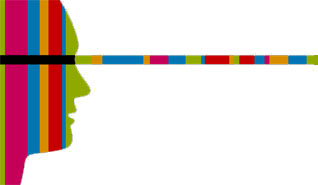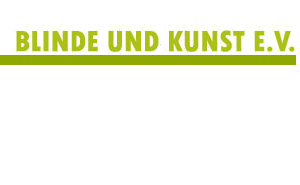I. Activities and concepts of “Blinde und Kunst e.V.” (BUK)
BUK was founded in 1992 as a nonprofit organization of blind, visually disabled and sighted artists, as well as people in these groups who are interested in the arts. It includes musicians, composers, writers, actors, sculptors and those who are just interested in presenting blindness in a new way. It was first inspired by the darkness-movement in germany. By darknessmovement I mean activities such as “dialogue in the dark” and the effects of this exhibition in a wider range of the blind community. Guiding sighted people into the dark in order to get on equal terms with them was the initial aim. To develop special expressions of art for darkness and consequently an art that is more adequate for blind and visually disabled people was the next idea. Under my curatory and – to mention only one curator – nina Zimmer who now works as curator at the Museum for arts in Basel – Buk thus conceptualized three exhibitions in Bergisch-Gladbach, Hamburg and Cologne, together with local associations of artists and the local association of blind and visually disabled people. The exhibition was called „Sinnenfinsternis“ (eclipse of the senses) which is a play on words with the german „Sonnenfinsternis“ (eclipse of the sun)– a forthcoming cosmic event at that time. Acousticc, tactual, olfactory and gustatory exhibits – and also ostensable visual ones – were presented in total darkness to a mostly sighted audience by blind and visually disabled people. Besides many exhibits by young, talented artists, the exhibitions also contained exhibits by internationally known artists like Ulrich Rückriehm and Ansgar Nierhoff..
II. Including blindness into the concept
But to conceptionalize exhibitions beyond the limitations of the eye as an idea also has begun to spread among „normal“ museums. in 1999 and 2000 together with Ulrike Stottropp from the Ruhrmuseum in Essen and the designer for exhibitions Uschi Gillman who became known to a greater audience through her exhibitions concerning the senses in Basel Museum for Gestaltung, I developed the auditory part of the exhibition „unten und oben“ which was a part of the larger project historama 2000 in the Ruhrgebiet. Here, that which was called the industrial nature-culture of the Ruhrgebiet simultaneously with the unavoidable concessions to sight was presented as an auditory and olfactory phenomenon. For a year I traveled through the whole region and tape recorded voices, sounds and, in fact, everything that was audible there for an auditory portrait. These recorded sounds were partially presented in the exhibition, and a CD also was produced. This is a good example of the ways in which exhibitions, from their initial conception, can be designed to accommodate the needs and special cognitive and perceptual enjoyments of blind and visually disabled people. and moreover, it also makes a new and wide ranging offer for sighted people in a museum. the beheld object is not necessarily a visual one. Itt might also be an acoustic, tactual or gustatory one.
III. Social contexts
This brings me to another point that I would like to make. art for all should not work in second or third instance behind the making of exhibitions solely conceptionalized for sighted people. On the contrary, it should be embedded into the very start of conception. so exhibitions, from their beginning, should include blind and visually disabled people. Some of you may have noticed already that I am speaking of disabled people and not about impaired ones. This is because it is society that makes people disabled. So it is also society that can enable us again. and even more than that. society is also obliged to do so. because society is the instance that, in the first place, enables or disables all human beings. Man is a social being. and all that human beings are capable of is made possible by society. That brings me to formulate some principles as a guideline for art for all.
IV. Principles
- All art must be made accessable to blind and visually disabled people. Not a single kind of art may be excluded. Every kind of art can be translated into a comprehensible language for blind people. This is true especially for photographs and paintings.
In this realm we are looking for new ideas and concepts that make art accessable. - The process of translation should be done in the communication of at least three groups: the blind for whom the translation is made. the museum experts and curators who best know about the objects and their cultural context. and with the assistance of artists who can best of all do the materialization of this translation process.
- In this process there should be included blind artists who most of all can serve as experts in an appropriate way of translating art for blind not only in a cognitive but also in a perceptual sense.
- So art for all in a broader social context should be imbedded into arts of all. By this I mean that the work of blind artists and the artistic expression of blind people should be encouraged, promoted and supported so that it will be made accessable for all. So also must art of blind people be made accessable for a mainly sighted society.
- Arts for all must be inclusive in the sense I have described in the example of the Ruhrmuseum. That means exhibitions must be inclusive from their very conception.
V. Means
- The permission to touch original sculptures for blind and visually disabled people.
- Where this is not possible Copies of the original exhibits must be made. these should be as close to the original in form, material and size as possible.
- There are to date an increasing number of acoustic exhibitions and installations that, it goes without saying, are interesting for blind and visually disabled persons. But in this field often the information between exhibitors and organizations for the blind flows very slowly, if at all. Here, a lot of work is still waiting for us. With a better established supply I am convinced that an intense demand can also be created among blind and visually disabled people.
- Walk-in installations such as for example in land-art should be made accessable.
- special guide services and guide systems should be available for every single blind or visually disabled visitor; not only for groups because only this way is equality realized.
- translation of visual arts into sound . Another example is the cooperation between BUK and a sighted artist who has translated several famous paintings into audible soundscapes. for example Henri Matisse` „the dance“, Salvador Dali´s „the constancy of memory“, Vincent van Gogh´s „grainfields with crows“ or „yellow cow“ by Franc Marc.
- translation of visual arts by description. Here the cultural context of the art enjoyment comes into play. No one can engage in enjoyment of arts without a cultural script at hand as a context of how to view and understand the perceived object of enjoyment. Such a script makes art accessable for cognition as well as for perception. and first of all this is true for the non-disabled population. So beauty does not only lie in the eyes of the beholder. If this were so, human kind could have exhausted itself by gawking at sunrises for the rest of evolution. But that has, as we all know, not been the end of the story. So beauty also lies in the cognitive, perceptive and habitual procedures of the beholder’s mind. and that is the main reason why, by using creative means, you can translate visual arts into blind arts.
- Let me take a moment to tell you about another example. As an ongoing activity in the “Römisch-Germanische Museum in Cologne, we are trying–mainly on an honorary basis–to make parts of their exhibition acccessable. Blind people are permitted to touch some original objects, a catalog in Braille and on CD is available and special guide service can be booked. In
addition to the catalogue there is a CD with two lectures by professor Werner Eck to illuminate the context of roman history for the visitor. the CD´s were especially and only recorded for that catalogue by a visually disabled sound enginier. he is – I am proud to say – also a member of BUK. To produce this catalogue we worked together with Mr. Ludwig from the Trierisch-Tonpost in the vikariat of Trier. This is one example of the many ways in which existing structures in the blindness system can support art for all. this is, in my opinion, a good example of how working for accessability can be done by including a number of tools into this process. Descriptive elements must be combined with tangible ones. Only in this way can art become an enjoyment. But it must be professionalized in a higher degree. Volunteer work cannot and may not be the appropriate basis.
VI. Aims and expectations
Certainly this process of making all arts accessable to blind people is a very big issue. So it will take a long time to be totally successful. and maybe we will forever stay behind the curve. For art always invents itself in new and unexpected ways. But this may not prevent us from setting our goals as high as possible. In the long run we should invent a new kind of language that bridges the gap between the sighted and the blind. But can we get a little more concrete? Of course.
- if not every museum so at least every big city – every centre of arts – should found a council of access where the above described process of translation can take place in the communication between curators, blind people and artists.
- Existing structures in the blindness system should be integrated to make museums and exhibitions accessable to blind people.
- But we must also care for sustainable effects. Merely a few exhibitions in a few locations will not be enough.
- In closing, let me say a few words on the topic of centre and periphery. Herein lies a problem. The centres for art differ from the centres of the blindness system. A solution to this problem could be an enhancement of art tourism for blind and visually disabled people. Tourism among blind and visually disabled people is a growing economic branch. and art is of course one major topic in tourism.
Vortrag gehalten im Rahmen der Tagung „art for all“, am 23.09.2006 in der Bundesblindenerziehungsinstitut Wien.
Text: Dr. Siegfried Saerberg
Übersetzung: Leslie Mader

